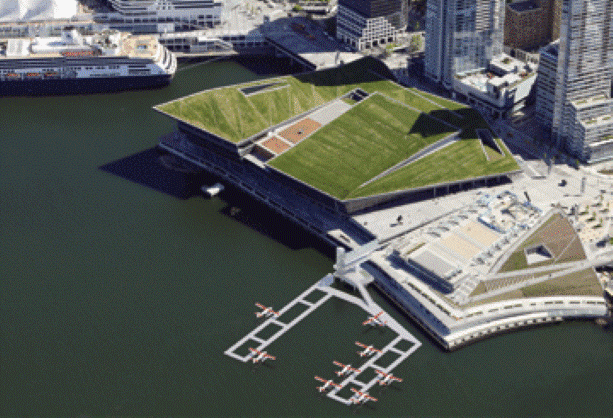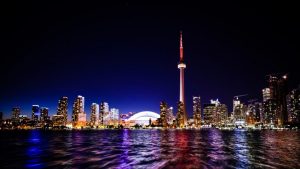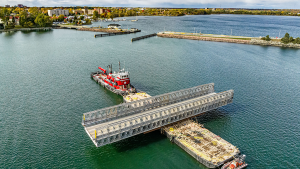A unique and environmentally friendly mooring system will anchor a new seaplane dock and terminal facility under construction in Vancouver.
A unique and environmentally friendly mooring system will anchor a new seaplane dock and terminal facility under construction in Vancouver. Vancouver Harbour Flight Centre started construction late last month on a new $22 million harbour development in front of the Trade and Convention Centre.
The company, which is a partnership between the Clarke Group of Companies and the Ledcor Group of Companies, is utilizing a unique expanding mooring device that adjusts to the movement of waves and tides.
“With this anchoring system we don’t need to use any piles, because it works like a high tech bungee cord,” said Miles Hollingbury, general manager of marine facilities with Vancouver Harbour Flight Centre.
“The Seaflex system provides a progressive resistance to both horizontal and vertical movement during all tidal conditions, currents and wave motion. The length of the Seaflex hawser increases or stretches with the tide maintaining tension at all times and dampens the effect of all movements in water.”
“In the past, marine floating docks were constructed and anchored using piles and/or concrete and steel conventional anchors along with galvanized chains,” said Hollingbury. “With piles you need a crane barge, which pounds and vibrates the piles into the sea floor. Piles can be obtrusive and setting them is perhaps a little more environmentally invasive.”
The Seaflex system has little or no harmful effects on marine ecosystems and doesn’t damage the sensitive seabed. When conventional anchors and galvanized chains are used the chain may tend to scour the sea floor during the rise and fall of the tide and because of wave action and damage vegetation. The chains can also become covered with vegetation and require inspection and cleaning periodically.
“With this system, helical anchors are drilled into the sea floor and that’s it,” said Hollingbury.
“Once your floats are ready they can be anchored in a few days. Piles can take a few weeks and are more expensive.”
The length of a rubber line called a hawsers is determined by the variation in water level. According to Hollingbury, the tide in Vancouver Harbour has a maximum range of about six metres.
The rubber hawsers maintain the position of the pontoon independent of water level variations or wave-induced movements.
“The biggest headache on this project has been designing the fuel room inside the convention centre and the overall fuel system, so that fuel can be safely delivered to all the floats allowing all seaplanes docking to be fuelled,” said Hollingbury.
The waterlot development will include 360 metres of seaplane docks, which will accommodate about 18 seaplane slips. The current terminal services about 12 planes and is a temporary facility that was moved from the foot of Burrard Street to facilitate construction of the convention centre. It’s located near the Harbour Green Park and the residential towers of Coal Harbour.
“We are going to have concrete floats with as few bridges as possible,” said Hollingbury. “This will give it a level linear look and the clean lines of the convention centre.”
Seaplane terminal facilities will occupy about 600 square metres of the Vancouver Convention Centre and will include ticketing counters, baggage and cargo handling, as well as a passenger lounge.
Hollingbury said the foundation for the stair tower from the convention centre was completed in November 2009, in the run up to the Olympics.
A new elevator tower will ensure that passengers and physically challenged visitors can easily access the facilities and seawall.
The facility will accommodate about 400 square metres of retail, food services and office space in addition to the 600 SM seaplane passenger terminal.
It is also expected that the new facility will boost retail, services and tourism.
Musson Cattell Mackey Partnership and WorleyParsons Engineers are the lead consultants for the design and engineering of the project.
The new development supports the growth of this transportation hub by increasing traffic and flights to new destinations on BC’s coast.
Consultants hired by the Vancouver Harbour Flight Centre estimate that direct construction will generate the equivalent of 165 full time jobs, $7.2 million in wages and add $10.7 million to provincial GDP.
Once the new seaplane docks and terminal facilities are completed in the spring of 2011, the company plans to build a yacht marina next to it.












Recent Comments
comments for this post are closed